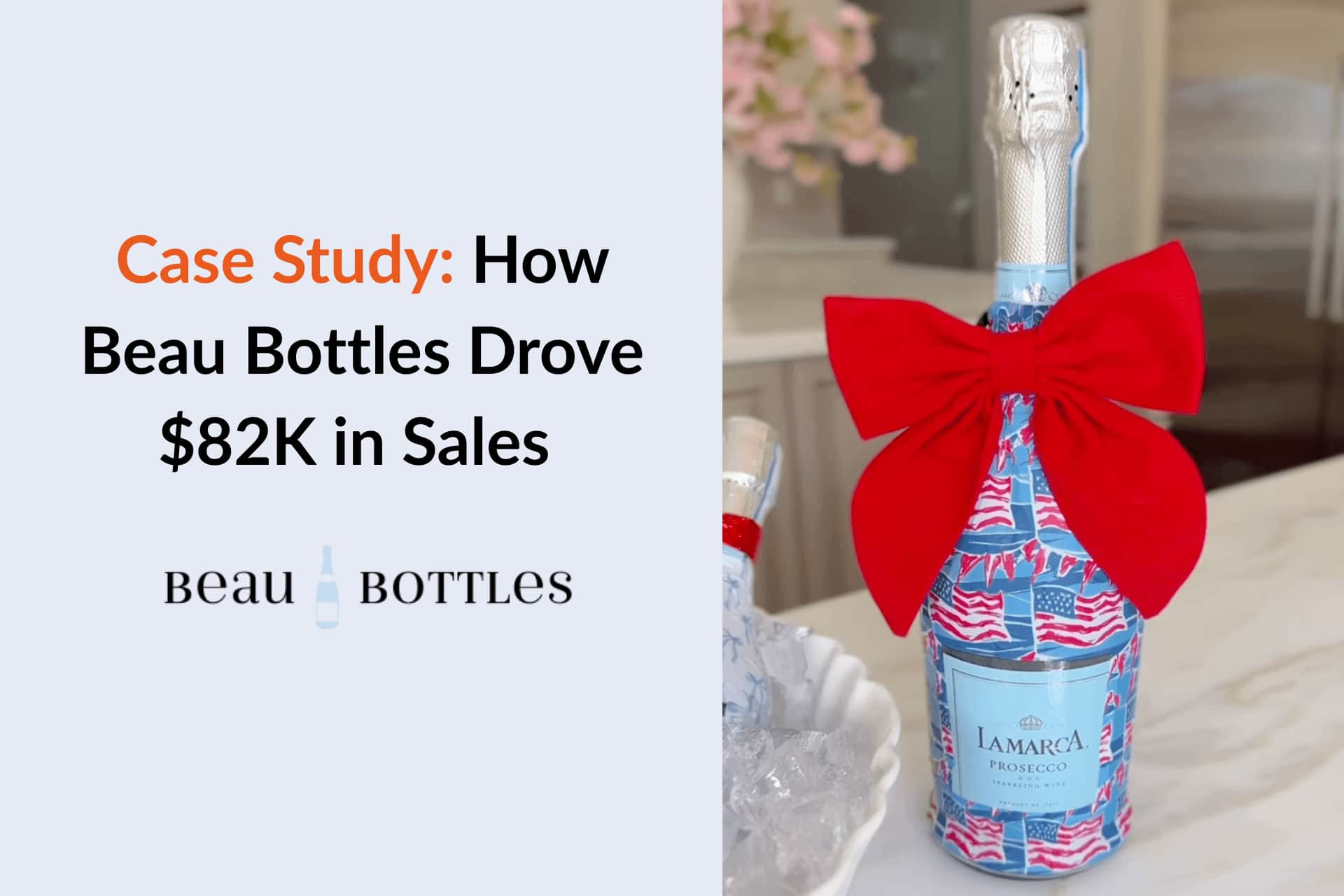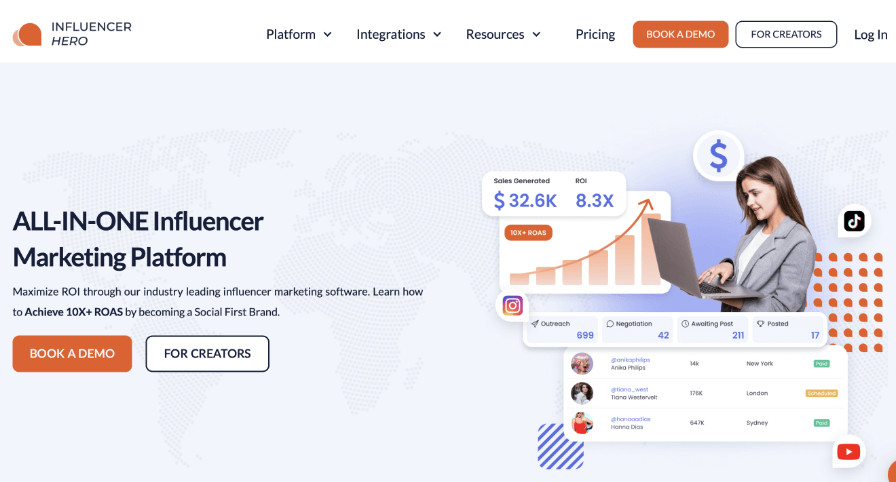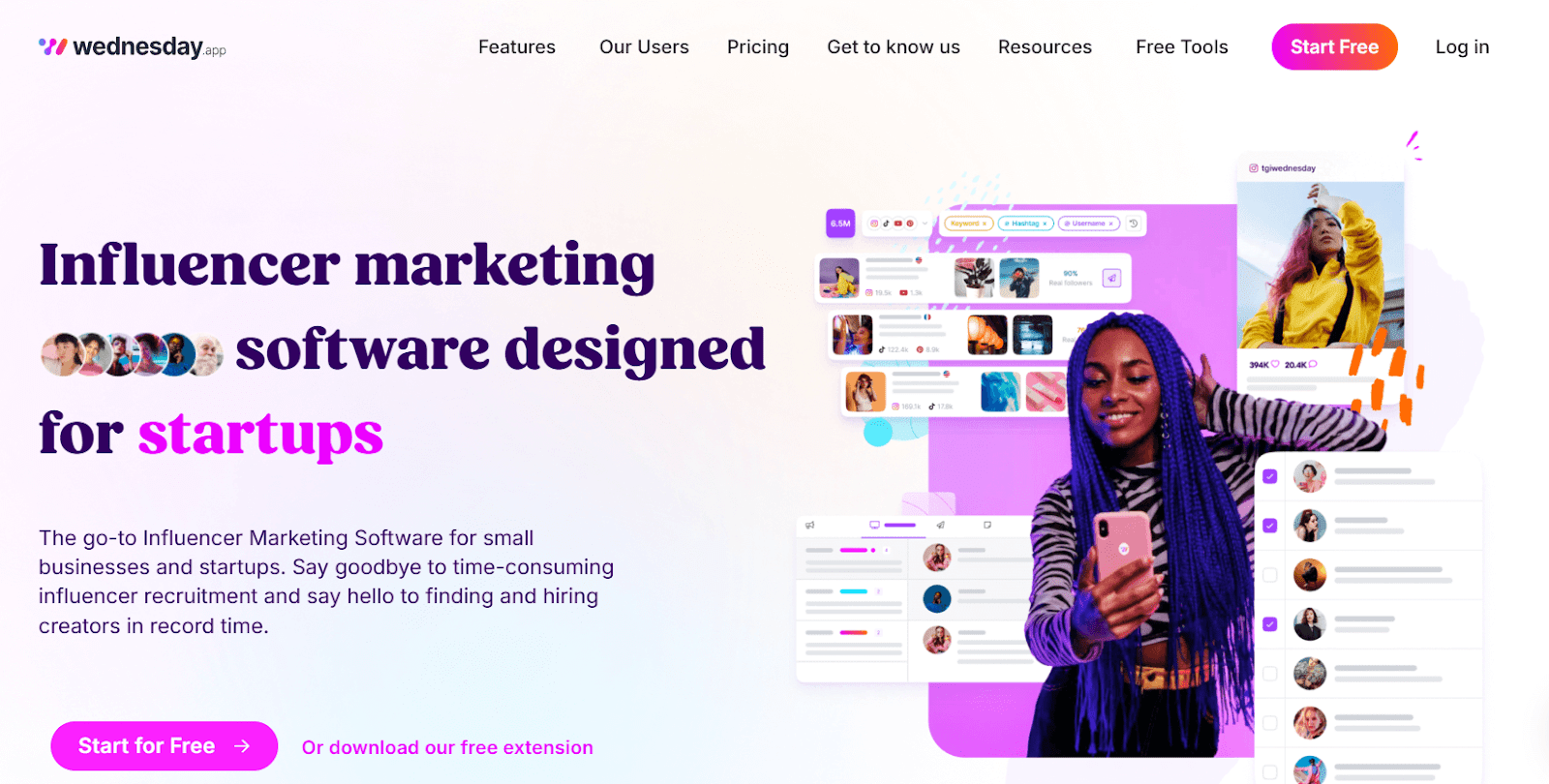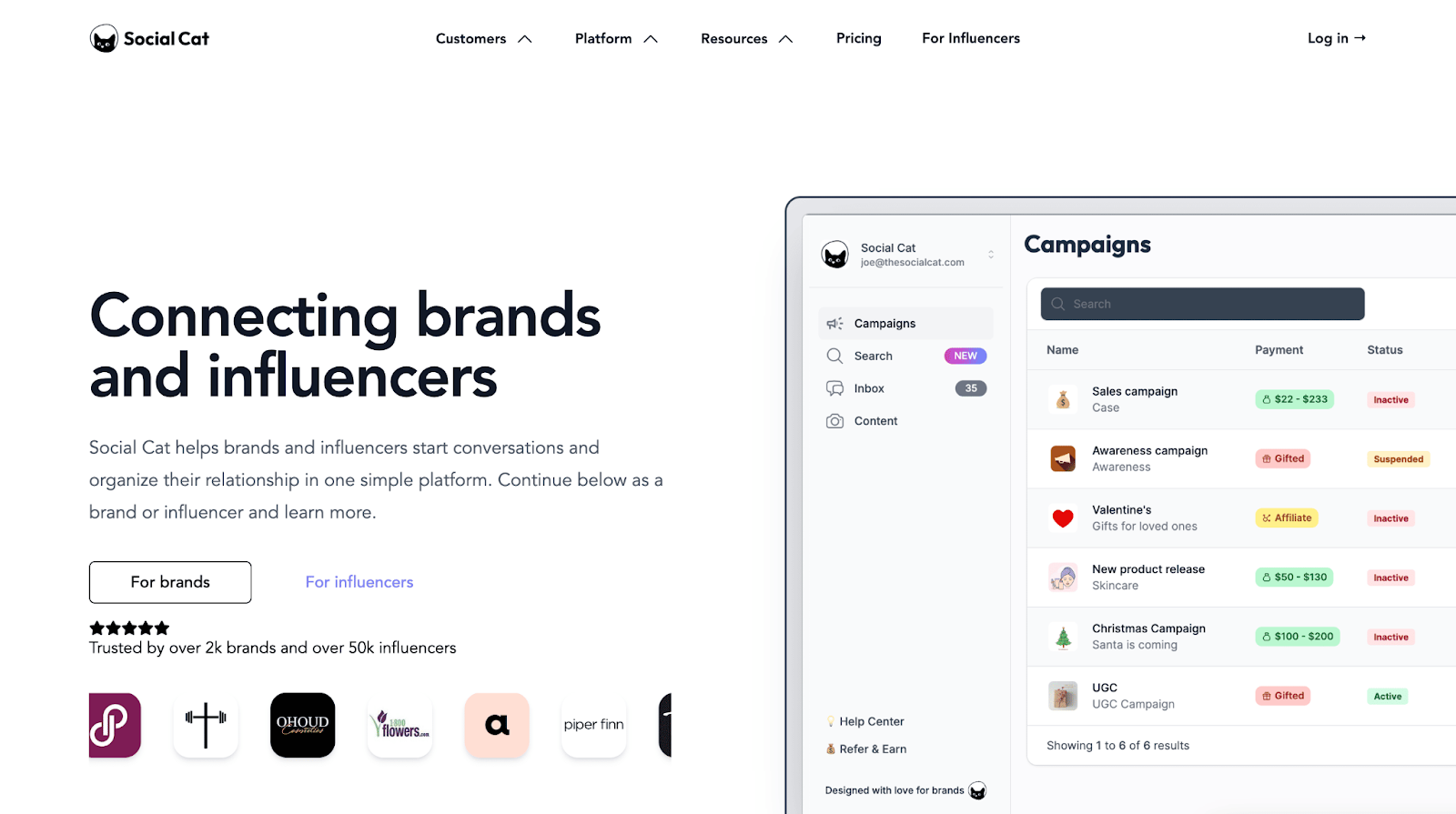





Boksi is a focused platform designed to help brands scale influencer and UGC campaigns on TikTok and Instagram. With features like AI-powered campaign briefs, a verified creator pool, and a comprehensive dashboard for managing applications and content purchases, Boksi provides an organized solution for producing high-quality influencer content. However, brands seeking automated influencer matching, multi-platform reach, or advanced outreach may find its capabilities limited.
Influencer marketing continues to grow rapidly, with Statista reporting that global influencer marketing spend is expected to reach $32.1 billion in 2025. This trend highlights the importance of choosing the right platform to efficiently manage campaigns and maximize audience engagement
Top 10 Boksi Alternatives
While Boksi provides brands with strong UGC production tools, vetted creators, and AI-powered campaign briefs, it does have limitations—particularly for companies seeking automated influencer matching, advanced outreach solutions, or more managed support.
Although Boksi offers a chat feature and creator application management, some brands note restrictions in direct communication with creators. This can make collaborations feel less fluid compared to platforms with more open or integrated communication channels.
Boksi does not currently provide an automated matching system to connect brands with the best creators for their campaigns. Instead, brands must manually search and filter through the database. While the vetted 25,000+ creator pool is valuable, the lack of smart matching may slow down campaign setup.
The platform is heavily self-service, requiring brands to manage most creator interactions, approvals, and edits on their own. For some teams, this level of control is useful, but others may find it time-consuming compared to platforms that offer more managed or hybrid services.
With around 25,000 vetted creators, Boksi’s database is smaller compared to larger influencer platforms that offer hundreds of thousands of profiles across multiple industries. While the creators are verified and reliable, brands looking for massive scale or niche diversity might find the selection limiting.
To compare the different platforms, we focused on central criteria that all must meet:

Platform Coverage: TikTok and Instagram.
Best For: Brands looking to scale influencer and UGC campaigns with a focus on creative content production. Boksi is especially suited for companies that want AI-powered briefing, private campaigns, and the ability to purchase custom influencer content with full usage rights.
Pricing: Boksi offers the following pricing structures:
Review: 4.0/5.0 (G2)
Ease of Use (UX/UI): Boksi provides a clean self-service dashboard for campaign management. Brands can compare campaigns, export reports, and manage applications in a streamlined way.
Customer Support: Core plan offers help chat, while Growth and Enterprise add dedicated managers and strategists for deeper collaboration support.

Platform Coverage: Influencer Hero supports influencer marketing across Instagram, TikTok, YouTube, Facebook, Pinterest, Snapchat, X (Twitter), and Twitch.
Best For: Influencer Hero is best for fast-scaling DTC brands and eCommerce businesses on Shopify, WooCommerce, or custom setups looking to run high-volume influencer, affiliate, and UGC campaigns from a single dashboard.
Pricing: Influencer Hero offers flexible monthly plans:
Reviews: 5.0 / 5.0 on Capterra
Ease of Use (UX/UI): Streamlined interface for rapid campaign setup and efficient navigation. New users can quickly manage creators and monitor progress.
Customer Support: Influencer Hero provides around-the-clock assistance via chat, email, and a rich knowledge library. Every subscription includes a personal account manager, and premium tiers unlock a private Slack channel and regular strategic check-ins for ongoing optimization.
Boksi offers strong UGC production tools, a vetted creator pool, and AI-generated briefs, but it remains self-service and focused mainly on TikTok and Instagram. Influencer Hero expands beyond these platforms, supporting TikTok, Instagram, YouTube, Twitch, Pinterest, Facebook, Snapchat, and X, providing brands with a more comprehensive influencer reach.
In terms of pricing, Boksi’s plans start at €599/month for Core and scale to custom enterprise solutions, whereas Influencer Hero offers flexible tiers from $649/month up to custom enterprise options. Influencer Hero also includes advanced campaign reporting, automated outreach, and Shopify/WooCommerce integrations, making it especially appealing for fast-scaling eCommerce brands.
While both platforms have strong dashboards and creator vetting, Influencer Hero’s multi-channel support and automated features make managing large-scale campaigns more efficient. Boksi may be more suitable for brands seeking a focused UGC tool on TikTok and Instagram without additional integrations.

Platform coverage: Instagram, YouTube and TikTok. Limited functionality for influencers from Snapchat and X.
Pricing: Modash pricing starts at $199 per month. They also offer a medium tier plan fixed at a $499 rate. The enterprise level plan has custom pricing.
Reviews: 4.9/5.0 (Capterra)
Ease of Use (UX/UI): Quick interface for influencer discovery with intuitive filters. No steep learning curve for new users.
Customer Support: Email support for all tiers, with priority chat for higher plans and a growing knowledge base.
Boksi focuses on TikTok and Instagram campaigns with a smaller vetted creator pool of 25,000 creators, while Modash covers Instagram, TikTok, and YouTube with robust audience analytics. Modash allows for detailed influencer scoring and pipeline management, making it easier to organize and track potential collaborators.
Pricing differs significantly: Boksi’s plans start at €599/month for Core, while Modash begins at $199/month with higher-tier plans at $499 and custom enterprise pricing. Brands choosing Modash gain access to API integrations and real-time post monitoring, which Boksi lacks.
Both platforms provide strong dashboards and audience insights, but Boksi emphasizes content production and UGC purchasing, while Modash excels in multi-platform discovery and audience vetting. Choosing between them depends on whether a brand prioritizes streamlined UGC creation or advanced influencer analytics.

Platform Coverage: Instagram, TikTok, and YouTube.
Best For: Social media teams needing advanced scheduling, performance measurement, and listening capabilities integrated with influencer collaboration.
Pricing: Sprout Social starts at $1,599 per user/month, $600/month for additional users; billed monthly or annually with a required 12-month contract.
Reviews: 4.5/5.0 (Capterra)
Ease of Use (UX/UI): Centralized dashboard for publishing, analytics, and engagement. Teams can navigate scheduling easily.
Customer Support: Email, chat, and phone support; dedicated managers for higher tiers.
Boksi is primarily a UGC-focused platform for TikTok and Instagram, while Sprout Social integrates publishing, engagement, analytics, and influencer collaboration across Instagram, TikTok, and YouTube. Sprout Social does not offer influencer discovery or content licensing automation, unlike Boksi’s vetted creator database.
Pricing reflects the scope: Boksi’s Core plan starts at €599/month, whereas Sprout Social begins at $1,599/user per month, making it a higher-cost option aimed at social media teams needing comprehensive management tools. Sprout Social provides advanced scheduling, reporting, and collaboration features, but brands must use external tools for influencer sourcing.
Brands seeking an all-in-one social media management solution may prefer Sprout Social, while those prioritizing UGC campaigns and verified creator access may find Boksi more practical. Each serves a different focus: content production versus full social workflow management.

Platform coverage: Upfluence covers Instagram, TikTok, YouTube, X, Twitch, Pinterest, and WordPress blogs.
Pricing:
Reviews: 4.6/5.0 (G2)
Best For: E-commerce brands and agencies looking to scale YouTube influencer outreach and track ROI.
Ease of Use (UX/UI): Robust interface for large-scale influencer marketing. Slightly steeper learning curve for new users.
Customer Support: Onboarding sessions, account managers for higher tiers, and responsive live chat/email support.
Boksi emphasizes AI-generated briefs, UGC purchasing, and TikTok/Instagram campaigns, whereas Upfluence offers a massive influencer database covering Instagram, TikTok, YouTube, X, Twitch, Pinterest, and blogs. Upfluence includes affiliate tracking, ecommerce integrations, and live campaign analytics for large-scale influencer management.
Pricing differs, with Boksi’s Core plan at €599/month and Upfluence’s Standard plan starting at $1,276/month, highlighting Upfluence’s focus on enterprise-scale features. Upfluence provides robust workflow tools and detailed ROI tracking, whereas Boksi prioritizes creative content production and private campaign management.
Both platforms have strong dashboards and vetted creator pools, but Upfluence is better suited for brands handling high-volume influencer campaigns with advanced analytics needs. Boksi remains an excellent choice for brands looking to streamline UGC creation on select platforms.

Platform coverage: Captiv8 covers Instagram, TikTok, Facebook, YouTube, X (formerly Twitter) and Twitch.
Pricing: $25.000 Annually (Annual commitment needed). Plus a $3.000 onboarding fee.
Reviews: 4.5/5.0 (G2)
Best for: Brands and agencies running large-scale influencer campaigns in platforms like Instagram, TikTok and YouTube.
Ease of Use (UX/UI): Full-featured platform ideal for experienced marketers. New users may need time to learn all functionalities.
Customer Support: Personalized onboarding, guidance, and dedicated account managers. Response time may vary for urgent issues.
Boksi and Captiv8 both cover major social platforms like Instagram, TikTok, and YouTube, but Captiv8 is designed for large-scale campaigns. Captiv8 requires a $25,000 annual commitment plus a $3,000 onboarding fee, which is much higher than Boksi’s pricing starting at €599 per month.
Boksi focuses on simplicity and quick creator discovery, while Captiv8 provides detailed influencer insights, custom dashboards, and secure reporting links. The latter is better for agencies or brands running high-budget campaigns with multiple stakeholders.
Both platforms support campaign communication and collaboration, but Captiv8 adds reusable search templates and workspaces for team coordination. Smaller teams or those with simpler workflows may find Boksi more accessible, while Captiv8 is optimized for scale and analytics-heavy campaigns.

Platform Coverage: CreatorIQ supports Instagram, TikTok, YouTube, Facebook, Pinterest, Twitch, and X (Twitter).
Pricing: CreatorIQ pricing is divided into 4 tiers:
An optional “Creator Connect” feature available for an additional $15,000 per yea
Reviews: 4.6/5.0 (G2)
Best For: Large-scale brands that require robust data controls, customizable workflows, and in-depth influencer analytics across international markets.
Ease of Use (UX/UI): Clean interface supports multi-market campaigns efficiently. Designed for teams managing large-scale operations.
Customer Support: Expert onboarding, dedicated managers, and strategy guidance. Ensures campaigns meet KPIs effectively.
Boksi and CreatorIQ both support multi-platform influencer campaigns, but CreatorIQ targets enterprise-level brands. CreatorIQ pricing starts at $35,000/year for basic access, significantly above Boksi’s subscription costs.
While Boksi simplifies influencer discovery and communication, CreatorIQ provides advanced workflow automation, global payment handling, and real-time campaign sync. Large teams managing thousands of creators benefit from CreatorIQ’s extensive controls.
Both platforms offer centralized messaging and analytics, but CreatorIQ’s dashboards are customizable for branded reporting. Boksi is easier for smaller teams to navigate, whereas CreatorIQ excels at scaling and complex, multi-market campaigns.


Platform Coverage: HypeAuditor supports Instagram, TikTok, YouTube, Twitch, X (Twitter), and Snapchat.
Pricing: Flexible usage-based pricing, with Business plans starting at around $10,000/year and Enterprise reaching up to $60,000/year.
Reviews: 4.6/5.0 (G2)
Best For: Teams that prioritize data accuracy, detecting fraudulent activity, and benchmarking competitors across various influencer platforms.
Ease of Use (UX/UI): Modern platform for marketing professionals. Some advanced tools require training.
Customer Support: Onboarding, live chat, email, and knowledge base. Helps teams leverage insights quickly.
Boksi and HypeAuditor cater to brands seeking influencer insights, but HypeAuditor specializes in data accuracy and fraud detection. Pricing for HypeAuditor’s Business plan starts around $10,000/year, which is higher than Boksi’s accessible tiers starting at €599.
Boksi offers a streamlined platform for influencer sourcing and UGC campaigns, while HypeAuditor delivers AI-powered matching and detailed audience analytics. The latter is ideal for marketers who prioritize fraud prevention and competitive benchmarking.
Both platforms provide reporting tools, but HypeAuditor emphasizes deep analytics and custom reports. Boksi is better suited for teams seeking simplicity and fast onboarding, whereas HypeAuditor is tailored to data-driven campaigns.

Platform Coverage: Instagram, TikTok, YouTube, X (formerly Twitter), Twitch, and Snapchat.
Pricing: GRIN’s yearly pricing starts at $25.000, with monthly payments available at $2.085/month. No discounts for upfront payments.
Best For: Best suited for DTC brands looking to centralize influencer relationship management in one streamlined system.
Reviews: 4.5/5.0 (G2)
Ease of Use (UX/UI): Intuitive and simple for campaign management. May slow down with large influencer sets or batch processing.
Customer Support: Offers onboarding, email, and chat support; premium customers receive dedicated strategists. Support quality may vary.
Boksi and GRIN both provide centralized influencer management solutions, but GRIN focuses on DTC brands with high-volume influencer campaigns. Pricing for GRIN starts at $2,085/month or $25,000 annually, which is higher than Boksi’s entry-level options at €599 per month.
While Boksi emphasizes TikTok and Instagram creator discovery with simple dashboards, GRIN offers extensive eCommerce integrations and automated campaign management. GRIN’s tools for Shopify and WooCommerce make gifting and affiliate tracking seamless, whereas Boksi keeps the workflow lighter and more manual.
Both platforms support centralized messaging and task management, but GRIN adds CRM syncing and automated reporting. Teams needing robust data insights and large-scale campaigns may favor GRIN, while smaller brands may prefer Boksi’s simplicity and affordability.

Platform Coverage: Instagram, TikTok, YouTube, Twitter, and Facebook.
Pricing:
Best for: Small businesses and emerging brands looking for a budget-friendly, intuitive influencer marketing solution with built-in CRM and AI-powered influencer discovery. Well-suited for lean teams expanding their influencer marketing without enterprise complexity.
Reviews: 4.6/5.0 (G2)
Ease of Use (UX/UI): Offers a clean and intuitive interface built for rapid campaign setup, though free-tier restrictions may limit high-volume users.
Customer Support: Includes onboarding support and email help, with more comprehensive guidance available only on higher tiers.
Boksi and Wednesday.App both provide tools for influencer discovery and campaign management, but they target slightly different audiences. Boksi is designed for brands running large-scale campaigns across TikTok and Instagram, while Wednesday.App is geared toward small businesses and emerging brands with a focus on budget-friendly influencer marketing.
In terms of pricing, Boksi starts at €599/month, offering a robust feature set for influencer search, campaign management, and reporting. Wednesday.App, by contrast, provides a free tier for light users, with paid plans ranging from $79 to $279/month depending on team size and access to advanced CRM and AI-powered discovery features.
While both platforms support streamlined influencer outreach and basic reporting, Wednesday.App emphasizes simplicity and AI-assisted message drafting for small teams. Boksi provides a more comprehensive dashboard, verified creator pools, and campaign reporting suitable for high-volume operations, making it preferable for brands needing detailed analytics and end-to-end management.

Platform Coverage: Instagram and TikTok, with a focus on micro and nano influencers for visually-driven campaigns.
Best for: Small to medium-sized brands launching or scaling influencer marketing with straightforward tools without enterprise complexity.
Pricing:
Review: 4.3/5.0 (Trustpilot)
Ease of Use (UX/UI): Beginner-friendly interface designed for straightforward campaign management and influencer collaboration.
Customer Support: Email support available for all plans, with priority assistance for Pro subscribers.
Boksi and SocialCat cater to brands looking for streamlined influencer marketing, though SocialCat focuses more on small to mid-sized businesses targeting Instagram and TikTok. Boksi supports TikTok and Instagram as well but includes additional features like verified creator pools and advanced campaign reporting.
Pricing differs significantly, with Boksi starting at €599/month for full access to its creator search, CRM, and UGC campaign tools. SocialCat offers lower entry points with plans ranging from $99 to $299/month, making it accessible for brands just beginning influencer marketing efforts.
Both platforms facilitate influencer communication, campaign tracking, and content rights management, but Boksi’s feature set is designed for higher-volume campaigns and robust analytics. SocialCat’s strength lies in simplicity and fast onboarding, with direct influencer applications and built-in basic metrics, ideal for lean teams or smaller campaigns.
Boksi is a powerful platform for brands aiming to scale influencer and UGC campaigns on TikTok and Instagram, offering AI-powered briefs, verified creator pools, and comprehensive campaign dashboards. Its strengths lie in content production, streamlined application management, and full usage rights for purchased influencer content, making it ideal for teams prioritizing creative output and organized workflows.
However, brands seeking automated influencer matching, advanced outreach, or multi-platform campaigns may find Boksi’s self-service model and limited platform coverage restrictive. Alternatives like Influencer Hero stand out because they provide broader network access, cross-platform support, and enhanced automation, which can better serve brands needing end-to-end influencer management and multi-channel strategy.
The top alternatives to Boksi for influencer marketing include Influencer Hero, Grin, Upfluence, and SproutSocial. Each of these platforms offers unique features and services that cater to different aspects of influencer marketing, from influencer discovery and analytics to campaign management and reporting. Depending on your specific needs, such as platform coverage, agency services, or specific features like influencer CRM and affiliate marketing, one of these alternatives may be a better fit for your brand than Boksi.
Boksi alternatives vary in their platform coverage, with most supporting major social media platforms like Instagram, YouTube, TikTok, and Facebook. Influencer Hero, for instance, offers a wide range of platform coverage including Twitter and Pinterest, making it an excellent choice for brands looking for extensive social media engagement. Meanwhile, platforms like Modash and HypeAuditor focus heavily on Instagram, YouTube, and TikTok, prioritizing in-depth analytics and influencer discovery on these platforms. Your choice should depend on where your target audience spends their time and which platforms are most relevant to your influencer marketing goals.
Yes, several Boksi alternatives offer agency services in addition to their software platforms, providing a more hands-on approach to influencer marketing. Influencer Hero, Upfluence, and Aspire are examples of platforms that combine software solutions with professional agency services, offering additional support in campaign strategy, execution, and management. This can be particularly beneficial for brands that prefer a comprehensive service package or need extra assistance in navigating the complexities of influencer marketing.
For influencer discovery and analytics, Influencer Hero is often highlighted as a strong alternative to Boksi. Known for its advanced AI-driven analytics, Influencer Hero specializes in providing detailed insights into influencer performance, audience demographics, and authenticity. Its focus on data accuracy makes it an excellent choice for brands that prioritize finding genuine influencers with engaged and relevant audiences. However, platforms like Tagger and Modash also offer robust analytics tools, making them worthy contenders depending on the depth and type of analytics you need.
Yes, several Boksi alternatives offer integration with eCommerce platforms to facilitate influencer gifting and collaborations. Influencer Hero, for instance, stands out with its seamless eCommerce integration capabilities, allowing brands to easily connect with influencers for product collaborations and gifting. This feature is particularly useful for brands looking to automate parts of their influencer marketing workflow, from product selection to dispatch. Influencer Hero also provides a connection to CMS like Shopify and WooCommerce, enabling automated product dispatch to influencers, highlighting the platform's strengths in streamlining influencer collaborations.



Schedule a Demo with one of our media experts below.